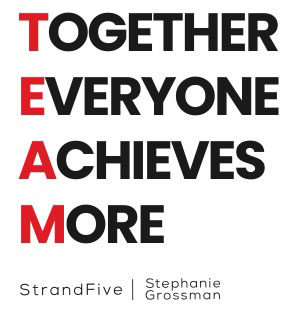 High-performing teams rely on more than talent alone; they depend on four critical dynamics: Trust, Engagement, Accountability, and Momentum. Each element plays a critical role in transforming individual effort into collective excellence.
High-performing teams rely on more than talent alone; they depend on four critical dynamics: Trust, Engagement, Accountability, and Momentum. Each element plays a critical role in transforming individual effort into collective excellence.
Trust: The Foundation of Team Success
Trust is the foundation of every high-performing team, often beginning with predictive trust—the confidence that teammates will deliver on commitments and perform reliably. While important, predictive trust alone isn’t enough for true team cohesion. High-performing teams rely on vulnerability-based trust, where members feel safe admitting mistakes, asking for help, and sharing ideas without fear of judgment.
Achieving this deeper trust starts with psychological safety, which creates the foundation for a culture of openness, respect, and support. In psychologically safe environments, team members feel secure enough to move beyond surface-level interactions, fostering authentic collaboration and stronger connections.
According to Brené Brown, vulnerability is a core strength that builds trust within teams. Leaders who model vulnerability create a culture where team members feel safe to engage in honest dialogue and mutual support, fostering stronger relationships and higher team cohesion.
Research by neuroeconomist Paul Zak further reinforces the importance of trust. His findings, published by HBR, show that high-trust environments increase productivity, lower stress, and promote team resilience, largely by triggering the release of oxytocin—a neurochemical linked to connection and cooperation.
Practices That Build Trust:
- Lead with Vulnerability: Model openness by admitting mistakes, seeking input, and demonstrating transparency to establish trust and set the tone for the team.
- Encourage Open Dialogue: Create an environment where team members feel comfortable expressing ideas, concerns, and differing perspectives, fostering honest and constructive communication.
- Create Opportunities for Collaboration: Design tasks or initiatives that require team members to depend on each other’s strengths, fostering trust through shared challenges and collective achievements.
Engagement: Cultivating Commitment and Purpose
Engagement goes beyond mere involvement; it’s about dedication to the team’s purpose and alignment with shared goals. When team members are fully engaged, they bring focus, energy, and commitment to their work. According to Gallup, highly engaged teams are 21% more profitable and experience significantly lower turnover, underscoring the importance of engagement in driving sustainable success.
A core aspect of engagement is fostering constructive conflict. In high-performing teams, members feel empowered to challenge ideas, ask tough questions, and voice differing perspectives in ways that ultimately strengthen alignment with the team’s goals. Constructive debate surfaces diverse viewpoints, sharpens ideas, and reinforces the team’s commitment to achieving shared outcomes.
Steps to Strengthen Engagement:
- Connect Roles to Purpose: Ensure each team member understands how their role contributes to the team’s overall mission, fostering a unified sense of purpose.
- Cultivate Constructive Conflict: Create a culture where constructive conflict is encouraged and expression of diverse viewpoints is expected. Reinforce that respectful debate is essential for the team’s collective growth.
- Support Continuous Development: Provide learning and development opportunities that keep the team’s engagement high and
- contribute to shared professional growth.
Accountability: Turning Shared Goals Into Results
Accountability transforms intentions into measurable outcomes. When team members take ownership of their roles and hold each other responsible for meeting shared goals, it creates a culture of reliability, trust, and high standards. Ownership isn’t just about individual contributions—it’s about building collective responsibility where everyone is invested in the team’s success.
Cultivating a Culture of Accountability:
- Set Clear Expectations: Define specific roles, goals, and responsibilities so every team member understands what’s expected and how their work contributes to the team’s success.
- Promote Collective Responsibility: Cultivate an environment where team members hold each other to shared commitments in a respectful and constructive manner.
- Empower Initiative and Ownership: Provide team members with the freedom to take initiative and responsibility for their work, instilling pride in their contributions and deepening their commitment to the team’s success.
Momentum: The Force Behind Progress
Momentum is what keeps a team moving forward, turning small wins into sustained energy and motivation. It builds upon each success, creating a positive cycle that drives the team toward larger goals. With consistent progress, teams gain the confidence to take on bigger challenges and remain focused even in tough circumstances.
Building Forward Momentum:
- Set Milestones: Break down larger goals into smaller, manageable steps to provide a clear sense of progress and maintain motivation.
- Celebrate Small Wins: Acknowledge and share minor achievements to energize the team and reinforce their commitment to the larger vision.
- Focus on Continuous Progress: Keep the team oriented toward forward movement by addressing challenges constructively and maintaining a focus on the next steps.
Bringing the TEAM Model to Life
Talent may start the journey, but it’s Trust, Engagement, Accountability, and Momentum that turn potential into performance. By focusing on these core elements, you can create a culture that fosters collaboration, resilience, and lasting success. Leaders who prioritize these key drivers create environments where team members don’t just participate—they excel, bringing out the best in each other and driving meaningful impact.
Incorporating the TEAM model isn’t just about improving performance; it’s about building a foundation for growth, adaptability, and shared achievement. When these elements come together, there’s no limit to what your team can accomplish.